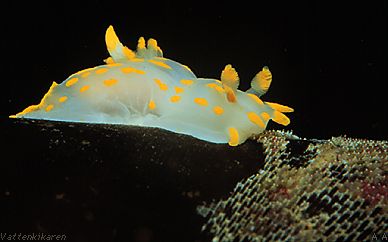 |
|
Protection against predators
<A HREF="nakensn.mov">[Watch a opisthobranch eating 1,3
MB]</A>
Opisthobranchs eating hydroids
which try to protect themselves with their stinging
cells .
Like plants, attached creatures are unable to flee from their predators.
This can result in the development of a physical or chemical defence mechanism.
Thorns and a hard casing can be protection enough, but poisons and bad tasting
substances are also used. Certain attached organisms have such good protection,
they are almost never preyed upon, but in certain cases, predators have
adapted and can penetrate protective measures. This is the case when nudibranchs
prey upon certain cnidarians
or sea-mats.
In many cases, protective measures also have a cost. To produce
protective structures or chemicals demands energy and material, therefore,
certain creatures develope some form of protection only when they are attacked.
This is the case with certain sea-mat colonies that develope thorns within
a couple of days after being attacked by a predator.

 |
Page
10 of 52 |
 |
|



